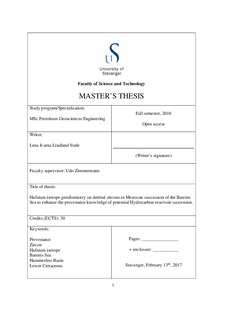| dc.contributor.advisor | Zimmermann, Udo | |
| dc.contributor.author | Støle, Lena Ivarna Lindland | |
| dc.coverage.spatial | Barents sea | nb_NO |
| dc.date.accessioned | 2017-05-16T11:25:00Z | |
| dc.date.available | 2017-05-16T11:25:00Z | |
| dc.date.issued | 2017-02-13 | |
| dc.identifier.uri | http://hdl.handle.net/11250/2442639 | |
| dc.description | Master's thesis in Petroleum Geoscience Engineering | nb_NO |
| dc.description.abstract | Technological advances have led to the development of various methods that allows us to more accurately pinpoint the timing of geological events using geochronology. One of the most established and acknowledged techniques is the dating of detrital zircons by the use of U-Pb laser ablation - inductively coupled plasma mass spectrometry - (LA-ICP-MS). In combination with U-Pb in situ analyses of the same zircon grain, the Lutetium-Hafnium isotope system represent one of the most innovative and powerful tools for geochronology and isotope. This thesis focuses on investigating the provenance of Mesozoic succession from seven deep drill cores provided by the Norwegian Petroleum Directorate (NPD). The analysis of the samples resulted in U-Pb isotope dating of 2457 detrital zircons (Matthews et al., subm.). The isotopic composition of Hf has been measured in 1151 of those zircon grains, using a laser ablation multi collector (MC)-ICP-MS to further investigate basin evolution trends and to propose potential source areas. With 21 Cretaceous samples, 8 Jurassic samples and 1 Triassic sample, the zircons varies in age from 206 Ma to 3465 Ma, allowing indirect analysis of mantle-derived Hf over a significant time span. With a systematic Lu-Hf isotope analysis of the detrital zircons in these samples, it was possible to deduct some information about the likely provenances and sources for Mesozoic (<370 Ma), Caledonian (450 - 370 Ma), Gothian (1700 Ma – 1450 Ma) and Neoacrhean (2.8 – 2.5 Ga) detrital zircons. The resulting data yielded the most juvenile εHf(t) signature for Gothian detrital grains, pointing to crustal formation ages related to the Svecofennian or Transscandinavian Igneous Belt (TIB). The youngest Mesozoic detrital grains, have more non-juvenile εHf(t) values between 12.92 to -17.35 indicating juvenile sources and reworking of crust, respectively magma mixing. Most Caledonian show non-juvenile εHf(t) values ranging from 11.61 to -15.94, where most have values of εHf(t) < 2. Around 10% of the grains show older Early Mesoproterozoic ages while a limited few are older. The oldest detritus is carefully discussed with model ages point to a Late Paleoarchean dominance and the oldest grain selected for Hf isotopes (NEZ2.063 from Kolje Fm; 3465 Ma) would point to a source in the northeast with an Eoarchean crustal component. | nb_NO |
| dc.language.iso | eng | nb_NO |
| dc.publisher | University of Stavanger, Norway | nb_NO |
| dc.relation.ispartofseries | Masteroppgave/UIS-TN-IPT/2017; | |
| dc.subject | petroleumsteknologi | nb_NO |
| dc.subject | petroleumsgeologi | nb_NO |
| dc.subject | petroleum geosciences engineering | nb_NO |
| dc.subject | provenance | nb_NO |
| dc.subject | zircon | nb_NO |
| dc.subject | Barents Sea | nb_NO |
| dc.subject | lower cretaceous | nb_NO |
| dc.subject | Barentshavet | nb_NO |
| dc.title | Hafnium isotope geochemistry on detrital zircons in Mesozoic succession of the Barents Sea to enhance the provenance knowledge of potential Hydrocarbon reservoir succession. | nb_NO |
| dc.type | Master thesis | nb_NO |
| dc.subject.nsi | VDP::Matematikk og Naturvitenskap: 400::Geofag: 450::Petroleumsgeologi og -geofysikk: 464 | nb_NO |
| dc.subject.nsi | VDP::Teknologi: 500::Berg‑ og petroleumsfag: 510::Geoteknikk: 513 | nb_NO |
| dc.source.pagenumber | 133 | nb_NO |
